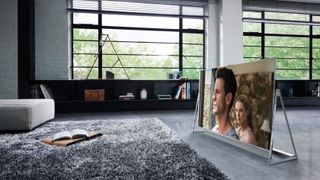Why you can trust TechRadar
The Panasonic 58DX802 is capable of delivering really quite spectacular pictures – provided you've tweaked the settings a bit.
What do these tweaks involve? First, when watching HDR I felt the need to push the 58DX802's Adaptive Backlight feature to its highest level of strength. This marginally increases the potential for seeing light 'jumps' in scenes featuring sudden and drastic changes in light level, but these occasional distractions are far preferable to the generalised greyness over dark areas you get with HDR on the 58DX802 if you leave the Adaptive Backlight feature set any lower.
Another tip is to handle Panasonic's Intelligent Frame Creation system with care, either turning it off completely (something I'd recommend when you're watching films) or, if you're particularly sensitive to judder, using the Medium setting when watching sport.

Finally, on balance I'd recommend against using the Dynamic Range Remaster feature Panasonic provides for making standard dynamic range content look a bit more like HDR. As well as – obviously –not delivering a truly 'as the content creator intended' picture, this feature tends to make dark areas look rather hollow and forced, and struggles to retain the sort of gorgeous colour balance the TV is capable of if you just leave SDR content in its native mode.
Right. Housekeeping covered, let's get down to the business of soaking up the mostly excellent pictures a well-set-up 58DX802 can deliver.
True colours
Particularly strong is its colour performance. Fed HDR content the screen serves up bold, vibrant tones that are clearly benefitting from the format's extra luminance and wider colour gamuts. But also, even more effectively, the 58DX802 excels when it comes to delivering the ultra-fine colour gradations and tiny tonal details/shifts that native 4K HDR images contain.
This is particularly impressive considering the panel isn't a 10-bit one, and is likely a result of Panasonic 'borrowing' colour technology from its pro monitor division. In fact, colours look more natural and effectively blended on the 58DX802 than on a couple of 10-bit panels I've seen.
Also key to the Panasonic 58DX802's colour success is the gorgeous balance the image retains across its whole colour palette, even during the most vibrant footage, and the overwhelming naturalism of the tones on offer if you use the TV's True Cinema mode. 'As the director intended' has long been Panasonic's mantra, and with colours in particular – provided you've followed my earlier advice regarding the Adaptive Backlight feature – the 58DX802 delivers on this promise superbly.

Having such pristine colours at its heart helps the 58DX802 sell its Ultra HD resolution better too.
Of course, for the time being at least you'll likely spend the vast majority of your time watching standard dynamic range content, not HDR. So it's handy that the 58DX802 is every bit as exquisite in its SDR colour finesse and detailing as it is with HDR.
As noted earlier, you can 'expand' the colour volume of SDR pictures with the Dynamic Range Remaster feature, but for me this loses that naturalism that Panasonic otherwise works so hard to provide – and ultimately, once you've experienced true HDR, going back to SDR, even SDR delivered as excellently as it is by the 58DX802, feels a touch sad.
With its Adaptive Backlight system running on maximum the 58DX802 deserves praise for its black level efforts too. It hits depths of the black stuff that are rare indeed in the edge-lit LCD world, and thanks to some excellent light management skills from the Studio Master HCX processing there's also plenty of shadow and dark colour detail in the darkness. This is not one of those LCD TVs that has to crush out detail to make black look at least something like black.

It has to be said that the 58DX802's HDR pictures aren't the brightest I've seen, especially when you (necessarily) use the maximum adaptive backlight setting; certainly Samsung's KS9000, Sony's XD9305 and Panasonic's own DX902 range look markedly brighter, as well as delivering slightly more tonal detail in the brightest areas than the 58DX802. But I never felt that I wasn't having an HDR experience, even if there are more extreme HDR experiences to be had elsewhere (if you spend more money to get them).
There are a couple of other issues to report with the 58DX802, though. One is that the picture's black level response – at least with HDR – really does take a significant hit if you use the Adaptive Backlight setting on anything lower than its highest setting, resulting in relatively grey, washed-out pictures that are pretty hard to love. This suggests the screen's native contrast performance isn't as good as it ideally would be, although at least the Adaptive Backlight feature provides a reasonable 'fix'.

A bigger issue is the appearance of light pollution – sometimes quite rigidly delineated – when bright objects appear against dark backdrops in extremely contrast-rich HDR content. The 58DX802 is hardly alone in suffering from this problem – it affects every HDR-capable edge-lit LCD TV I've seen to date to some extent, and it's actually slightly less common or aggressive with the 58DX802 than it is with many of its rivals – but it's there sufficiently often to at least remind us that edge-lit LCD TVs will likely never be as strong with HDR as direct-lit LCD or OLED TVs.
One last, much smaller niggle is the way in which slight motion blur can reduce the sense of sharpness the screen's Ultra HD resolution and excellent colour reproduction otherwise delivers so expertly.
The 58DX802 deserves to finish this section on a high note, though, so I'll point out that it takes only 34ms on average to render its pictures, making it an effective gaming monitor as well as a very fine TV.
Usability
The Firefox-based operating system Panasonic uses for accessing content and other smart features is excellent. It's attractive to look at, straightforwardly structured and exceptionally easy to customise.
The need to be quite precise about a couple of aspects of the TV's picture settings to get anything like the best picture quality makes them a little less effortless to use than they might be, and Panasonic's settings menus are rather long-winded and intimidating compared with the simple attractiveness of its smart TV OS. There are some rather abstract explanations of what certain features do in the on-screen instructions, too.
Sound quality
Whatever your thoughts about the external speaker from a design perspective, there's no denying its audio prowess. It's always a pleasure to hear the directness and relative 'attack' you get from a speaker system that fires right towards you, for starters, but this relatively straightforward benefit of the 58DX802 is underpinned in dramatic style by spectacular amounts of tightly controlled bass by flat TV standards; an expansive, open-sounding and richly detailed mid-range; and crisp, clean, harshness-free trebles.
The speaker delivers a soundstage that spreads far beyond its physical confines without losing cohesion too, and I was relieved to find that provided you don't sit it any lower than directly between the TV's legs it also manages to make voices sound like they're coming from the on-screen action, rather than from below the picture.
In short, the 58DX802 is a prime contender for best-sounding TV of the year – and at a price considerably lower than the main sonic rival to it I've heard so far, the LG OLED65E6.
John has been writing about home entertainment technology for more than two decades - an especially impressive feat considering he still claims to only be 35 years old (yeah, right). In that time he’s reviewed hundreds if not thousands of TVs, projectors and speakers, and spent frankly far too long sitting by himself in a dark room.


